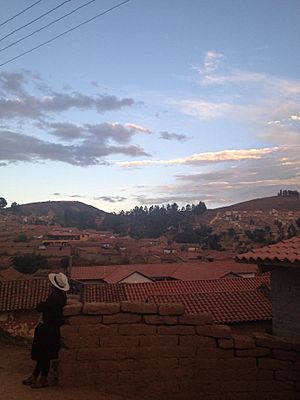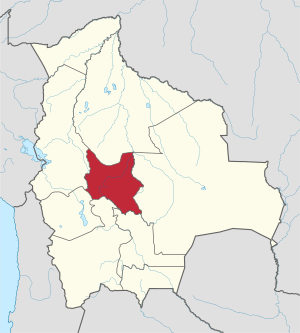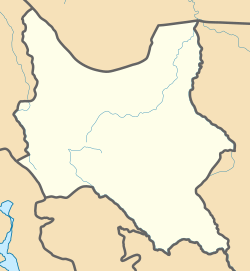Totora, Cochabamba facts for kids
Quick facts for kids
Totora
|
||
|---|---|---|
|
Town
|
||

Skyline, 2012
|
||
|
||
| Nickname(s):
City of the Pianos
|
||

Location of Cochabamba Department in Bolivia
|
||
| Country | Bolivia | |
| Department | Cochabama | |
| Province | Carrasco | |
| Settled | 24 June 1876 | |
| Incorporated (city) | 27 October 1894 | |
| Named for | Tjutura, now-extinct aquatic plant from the area | |
| Government | ||
| • Type | Mayor–council government | |
| Area | ||
| • Total | 42 km2 (16 sq mi) | |
| Elevation | 2,805 m (9,203 ft) | |
| Population
(2012)
|
||
| • Total | 1,925 | |
| • Density | 45.8/km2 (118.7/sq mi) | |
| Demonym(s) | Totoreños | |
| Ethnicity | ||
| • Quechua | 88.6% | |
| • Aymara | 2.2% | |
| • Guaraní | 1.4% | |
| • Chiquitano | 0.3% | |
| • Other | 7.3% | |
| Time zone | UTC-4 (BOT) | |
| Country code | +591 4 | |
Totora is a town in Bolivia. Its name comes from the Aymara and Quechua word for a type of aquatic plant. It is located in the Carrasco Province of the Cochabamba Department. Totora is the main town and capital of its municipality.
In 2012, about 1,925 people lived there. The first people to settle in this area were the Inca. Totora officially became a settlement in 1876. The Bolivian government declared it a town in 1894.
Contents
Discovering Totora's Past
The Inca Empire was home to the first people who lived in the Totora area. From 1530 to 1722, the land was controlled by the Spanish. They mostly used the land for growing plants like coca.
The town was first mentioned in 1639. This was when a landowner named Don Fernando García Murillo set up a small church. Totora officially became a town on June 24, 1876. This happened after the Mizque Municipality was split into two areas.
The Bolivian Government officially declared Totora a city on October 27, 1894. The first people to live in Totora were rich landowners, traders, and people who made textiles. The town was also an important stop for trading between western and eastern Bolivia.
On May 22, 1998, a strong earthquake hit the Totora and Aiquile areas. It was a very serious event for the country. In 2000, the United Nations recognized Totora as a "Cultural Heritage of Humanity." This means it is a special place with important history and culture.
Totora's Location and Weather
Totora is known for its beautiful colonial-style buildings. The streets are laid out in a unique way because of the town's hilly land. Most houses have walls made of adobe, dirt floors, and cement roofs.
Totora's Climate
| Climate data for Pocona , elevation 2,658 m (8,720 ft) | |||||||||||||
|---|---|---|---|---|---|---|---|---|---|---|---|---|---|
| Month | Jan | Feb | Mar | Apr | May | Jun | Jul | Aug | Sep | Oct | Nov | Dec | Year |
| Mean daily maximum °C (°F) | 21.9 (71.4) |
21.1 (70.0) |
20.4 (68.7) |
19.6 (67.3) |
18.6 (65.5) |
17.9 (64.2) |
17.0 (62.6) |
18.5 (65.3) |
20.7 (69.3) |
22.5 (72.5) |
22.6 (72.7) |
22.3 (72.1) |
20.3 (68.5) |
| Daily mean °C (°F) | 15.6 (60.1) |
15.1 (59.2) |
14.5 (58.1) |
13.6 (56.5) |
12.0 (53.6) |
10.9 (51.6) |
10.2 (50.4) |
11.6 (52.9) |
13.4 (56.1) |
15.3 (59.5) |
15.8 (60.4) |
15.9 (60.6) |
13.7 (56.6) |
| Mean daily minimum °C (°F) | 9.4 (48.9) |
9.1 (48.4) |
8.7 (47.7) |
7.6 (45.7) |
5.3 (41.5) |
4.0 (39.2) |
3.4 (38.1) |
4.6 (40.3) |
6.2 (43.2) |
8.0 (46.4) |
9.0 (48.2) |
9.4 (48.9) |
7.1 (44.7) |
| Average precipitation mm (inches) | 195.2 (7.69) |
158.6 (6.24) |
122.6 (4.83) |
37.2 (1.46) |
6.2 (0.24) |
1.6 (0.06) |
4.6 (0.18) |
5.7 (0.22) |
12.3 (0.48) |
38.9 (1.53) |
78.9 (3.11) |
151.8 (5.98) |
813.6 (32.02) |
| Average precipitation days | 12.9 | 12.3 | 9.0 | 3.4 | 0.6 | 0.2 | 0.5 | 0.9 | 1.8 | 4.5 | 7.0 | 10.8 | 63.9 |
| Average relative humidity (%) | 68.1 | 66.6 | 66.6 | 63.3 | 51.7 | 44.3 | 39.2 | 43.3 | 48.3 | 54.2 | 62.6 | 62.5 | 55.9 |
| Source: Servicio Nacional de Meteorología e Hidrología de Bolivia | |||||||||||||
The Carrasco National Park is located northeast of Totora. This park was created in 1991. It covers a huge area of about 6,226 square kilometers. The park has many different elevations, from 300 to 4,700 meters high.
It is believed that the park is home to 3,000 different types of plants. There are also an estimated 700 kinds of birds. About 382 types of other wildlife have been confirmed in the park.
Some popular places to visit in Totora include the House of Culture. This used to be a large house but is now a museum. There are also old colonial bridges and the main town plaza. Another attraction is Phaqcha (also called Pajcha), which is a 30-meter high waterfall. Julpe is a place nearby that has ancient cave paintings.
Totora's People and Population
| Historical populations | ||
|---|---|---|
| Year | Pop. | ±% p.a. |
| 1845 | 1,000 | — |
| 1900 | 3,501 | +2.30% |
| 1992 | 1,347 | −1.03% |
| 2001 | 1,597 | +1.91% |
| 2012 | 1,925 | +1.71% |
| Sources: | ||
In 2012, the population of Totora was 1,925 people. This was a small increase from 2001. There were more women (1,033) than men (892) living in the town. In 2012, there were 1,069 homes and 457 families. On average, about 1.8 people lived in each home.
Historically, the highest population for Totora was 3,501 in 1992. The lowest was 1,000 people in 1845. Totora covers an area of about 42 square kilometers. This means there are about 46 people living per square kilometer.
Totora is the most populated place in its municipality. It has 13.1% of the total population. In 2012, it was the only town in its area with more than 1,000 people.
Most people in Totora are from the Quechua group (88.6%). Other groups include Aymara (2.2%) and Guaraní (1.4%). Most people (65.4%) speak either Spanish or Quechua, or both. As of 2005, most people (98%) follow the Catholic religion.
Totora's Economy
In 2013, a special agreement was made in Totora. About 300 families in the town agreed to grow wheat. This wheat would then be sold to five different cereal companies in Cochabamba. This helps the local economy.
Learning in Totora
Totora has three schools. There is José Carrasco Torrico High School, named after a former Vice President. There are also Martin Mostajo Middle School and La Paz Middle School. The high school has 320 students. The new middle school was built in 2013. It has 11 classrooms and can teach up to 250 students.
In 2001, about 82.4% of the people in Totora could read and write. This was a little lower than the average for all of Bolivia, which was 86.7%.
Getting Around Totora
There are two main roads to reach Totora. You can take Route 7 if you are coming from Cochabamba. If you are coming from Sucre, you can use Route 5. The Bolivian Department of Education is working on building a new road. This road will connect Tarata to Totora. Both of these towns are important historical places.
See also
 In Spanish: Totora (Cochabamba) para niños
In Spanish: Totora (Cochabamba) para niños


